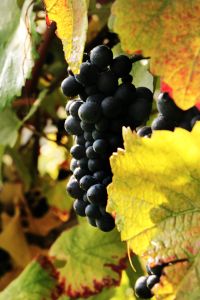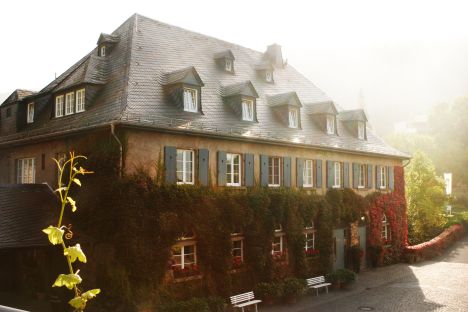The rehearsal took place on 11 September 2008 in the rooms of the Assmannshausen domain. Thanks to detailed work reports from that time, the circumstances and data of vineyard work, harvesting and wine processing from almost all vintages have survived to this day.
A warm, sunny year. The
harvest began on 1 October, the
main harvest ended on 24 October. Tiny yield of 2.7 hl/ha.
89 Bright, shiny garnet. Firm and lively on the nose, spicy scent of partly dried red berries and lots of
cassis with light fig tones, delicate old woody notes and distinct minerality. Also firm in the mouth, but rather slender, present acidity, very fine
tannin, lots of bite on the palate, delicately woody spice in the background, very good persistence and a certain depth, incredibly fresh, relatively long.
Due to strong coulure again a very low yield.
Harvest began on 15 October, but the
harvest dragged on - mainly due to
lack of space - until the beginning of November.
Frost in the night from 22 to 23 October.
84 Garnet with a fawn tinge. Slightly matured, a bit washed out, malty nose, with air a bit clearer and also
cooler, with red berry tones and cassis. Also a little washed out in the mouth, again also malty-vegetable, in addition also red and black berries, slight acid bite, somewhat sandy, drying tannins, certain melting, dries out further with air, good finish.
Good year with the highest yield recorded up to then of around 55 hl/ha.
Main harvest from 5 to 23 October.
92 Ruby-garnet with fawn notes. Lots of cassis in the nose, sage, some malt and caramel, but also red berries. Soft, ripe and juicy in the mouth, relatively present fruit, cassis aromas and sage again, fine acid bite, very slightly sandy tannins, delicate wood tones, mineral on the palate, persistent, relatively warm style, deep and very long.
A late blossom, but a partly very hot summer made up for the ripening deficit, damp weather from the end of August caused rot. October, however, was largely dry and saved the quality. The
harvest of the Spätburgunder lasted from 6 to 27 October, with rain starting again towards the end of the harvest.
85 Shiny garnet to fawn brown. Slightly washed-out scent of sage and other herbs, malt, candied blackcurrants and tobacco. Soft and spicy in the mouth, again very slightly washed out, malty notes and herbal notes, slightly sandy tannin on the palate, some melting, not too deep but nice to drink, slightly sandy and malty finish.
After a hard winter, the prospects for a reasonable
harvest were already slim, coulure and pest infestation once again drastically decimated the quantity to finally only 4.5 hl/ha. The dry weather from August onwards, especially the friendly
harvest weather, nevertheless ensured very good quality. The
main harvest began on 12 October and ended on 20 October.
86 Rather light fawn brown. Spicy, mineral cassis scent, some red berries and sage. Fine fruit and lots of acidity in the mouth, herbal notes, present, partly drying tannins, some melting on the palate, good persistence and depth, mineral notes, slightly sandy-drying finish.
Considered one of the best vintages since records began. After unfavourable flowering weather, which caused heavy ripening, a long, dry and warm growing season followed. The
harvest weather between 6 and 19 October was also optimal. The yield was only 25 hl/ha with excellent quality. Due to a
lack of harvesting personnel, school children were partly used in autumn.
84 Light ruby-garnet. Slightly malty and vegetable aroma of black and red berries with slightly cheesy hints. Somewhat washed-out fruit in the mouth, sweet melting, malt and candy aromas, planty notes, creamy and also a little cheesy tones again, relatively sandy tannin, good persistence on the palate, good finish.
1944 Assmannshäuser Höllenberg Pinot Noir Cabinet
Unfavourable weather during the blossom and cloudy weather during the harvest (the main harvest took place between 10 and 21 October) resulted in low quantities and moderate quality. Again, due to a lack of staff, schoolchildren and country maidens had to be used for the harvest in autumn. Again and again, the harvest was disrupted by air raids and low-flying aircraft.
81 Not quite clear orange-red. Vegetal, slightly petrol nose with somewhat washed-out red and black berry notes and some tobacco. Vegetal also in the mouth, sandy-rough tannins, slightly washed-out berry tones, caramel and cassis, decent finish.
1945 Assmannshäuser Höllenberg Pinot Noir Natur Cabinet
Again, vineyard work constantly disturbed by air raids, from 18 March also increasingly artillery fire. Americans, Poles and Lithuanians decimated the vineyards. The women of the village took care of the vineyard.
92 Shiny ruby-garnet. Very beautiful, absolutely typical, finely spicy and herbaceous aroma of ripe red berries and lots of cassis with mineral and also slightly sulphurous tones. Ripe, crystal clear, relatively warm fruit, quite present tannins, mineral on the palate, persistent, seems surprisingly fresh, deep and lively, delicate woody tones, very good, if slightly sandy-drying finish. Only the slightly noticeable sulphur prevents an even higher rating.
1946 Assmannshäuser Höllenberg Pinot Noir Natur Cabinet
Warm spring, but cool weather during flowering, mixed summer.
91 Relatively dark ruby-garnet. Woody-spicy scent of partly preserved ripe red and black berries with smoky-roasty tones, delicate malty notes and aromas of dried flowers. Ripe, clear fruit with delicate vegetal tones, lots of juice and sweet melting, firm structure, still quite fresh, good depth, mineral notes, amazing persistence, very long.
1947 Assmannshäuser Höllenberg Pinot Noir Natur Cabinet
There was still little trained staff for the vineyard work, but the hot, dry year made the work easier. Only healthy grapes were harvested. The main harvest took place from 24 September to 8 October.
93 Rather dark garnet. Highly ripe, rather dark berries in the nose, some liqueur-like notes, sweet spicy hints, malt, a touch of chocolate and also woody traces. Highly ripe also in the mouth, candied fruit, plums, dark caramel and again also malt, fine sandy, crumbly tannin, sweet melting and little acidity, powerful, deep and lasting, in captivating form, without age tones, warm style, very long.
1953 Assmannshäuser Höllenberg Pinot Noir Natur Cabinet
Due to coulure only a moderate harvest of 30 hl/ha, optimal weather conditions, dry in autumn, but also misty and hazy, very high must weights.
86 Rather light ruby-orange. Deep, herbal and spicy nose with dried floral and mineral notes, behind dried red and black berries. Sweetly plummy and red berry in the mouth, very powerful and alcoholic, sandy, somewhat rough tannins, woody notes, malt and candy tones, spices and sage, a little rustic style, relatively warm, drying finish.
1959 Assmannshäuser Höllenberg Pinot Noir Natur Cabinet
Ideal weather from blossom to harvest, summer of the century, warm and sunny during the day in autumn, freezing cold at night. The main harvest took place from 28 September to 15 October, the yield was 40 hl/ha. Unusually stormy fermentation.
89 Relatively bright Ruby. Slightly old woody scent of ripe red berries, some plums and vegetables with mineral notes. Sweet, ripe fruit in the mouth, fine sandy and somewhat drying tannins, mineral on the palate, delicate wood spice, good persistence on the palate, lots of power and noticeable alcohol, warm style, good depth, long.


